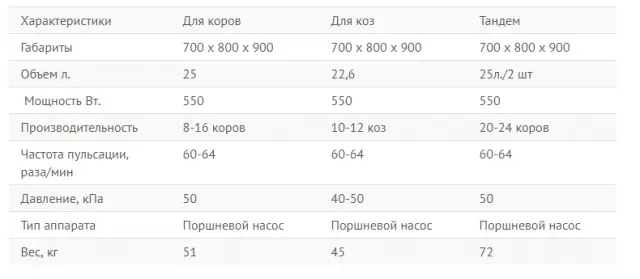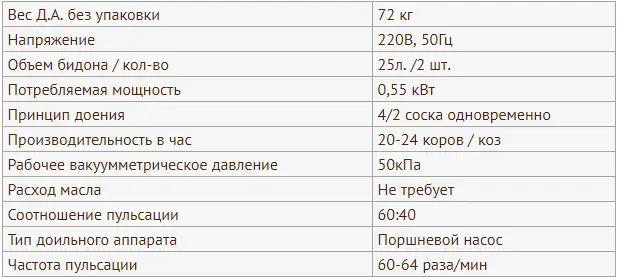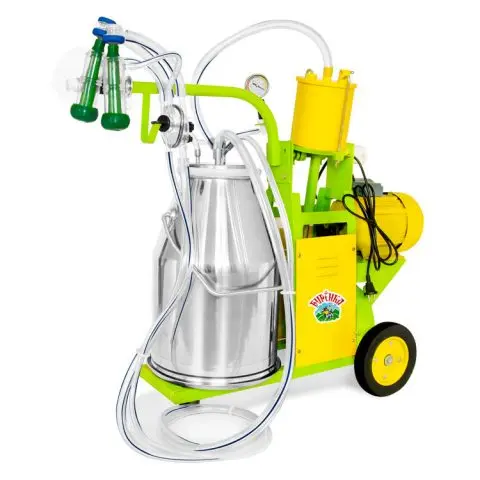Contents
The Burenka milking machine has been tested by many domestic cow owners. There are a lot of reviews about the equipment. Some people like it, others don’t. The range of milking machines produced under the Burenka brand is large. The manufacturer offers dry and oil type units designed for milking a certain number of livestock.
Advantages and disadvantages of milking machines for Burenka cows

In general, Burenka equipment has the following advantages:
- high-quality hoses and elastic teat rubber;
- capacious stainless steel container;
- piston models are not afraid of milk getting into the piston;
- high quality shipping container.
The disadvantages include:
- heavy equipment;
- there is no place for winding the network wire;
- the presence of a large number of moving parts creates a loud sound during operation;
- sometimes there is an unstable milking process.
There are a lot of negative reviews of the owners about the Burenka milking machine, and most of them affect piston models. Animal breeders complain about too loud work. Inside the engine, tapping is clearly audible, characteristic of the operation of the crankshaft with pistons.
A problem for many is considered to be a long-term increase in working pressure. From the moment of switching on, from 30 to 60 seconds should elapse. There were problems when measuring the pulsation. Instead of the recommended frequency of 60 cycles / min. the equipment produces up to 76 cycles / min. In the passport data, the ripple ratio parameter is 60:40. However, the pump acts as a pulsator for the Burenka piston unit. The movement of the pistons occurs without delay, which gives the right to assume a real pulsation ratio of 50:50.
During operation, for some models, the third cycle of milking does not work well – rest. The teat rubber does not fully open, the cow feels discomfort. Milk is sometimes not fully expressed.
The lineup
Conventionally, Burenka aggregates can be divided into three groups:
- Dry type models for milking 5 cows. The milking machines are equipped with a 0,75 kW engine with a rotation speed of 3 thousand revolutions / min.
- Dry type models for milking 10 cows. The devices are equipped with a 0,55 kW engine with a rotation speed of 1,5 thousand revolutions / min.
- Oil type models for milking 10 cows. The milking machines use a 0,75 kW motor with a rotation speed of 3 thousand revolutions / min.
Each group includes a model with certain characteristics. The classification of devices is indicated by the abbreviation “Combi”, “Standard”, “Euro”.
For home use, Burenka-1 devices of the basic configuration with the designation “Standard” are suitable. The milking machine can serve up to 8 cows. The apparatus Burenka-1 with the abbreviation “Euro” has small dimensions. The equipment serves 7 cows per hour. The Burenka-1 N model is popular due to the presence of a dry vacuum pump that can function away from the teat cups.
The Burenka-2 model has improved characteristics. Two cows can be connected to the device at the same time. For an hour, the milking machine serves up to 20 heads. The dry type vacuum pump pumps 200 l of milk/min.
The milking machine Burenka 3m, equipped with an oil-type pump, has improved characteristics. The equipment is equipped with a 0,75 kW motor with a rotation speed of 3000 rpm. The model is designed for large farms. The general instruction for the Burenka 3m milking machine says that three cows can be connected for milking at the same time. Productivity is up to 30 cows per hour.
The characteristics of several piston-type models for domestic purposes for milking goats and cows are shown in the table:

On the video, the operation of the Burenka piston apparatus
Technical characteristics of milking machines
The Ukrainian manufacturer of milking machines Burenka has equipped its equipment with a stainless steel can, which has a better effect on the quality of milk. Hoses for milk transportation are made of transparent silicone, which improves the process of visual control of milking. Inserts of milking cups Burenka are elastic, do not irritate teats and udders.
Burenka devices have the following qualities:
- reliable work;
- capacious container for collecting milk;
- good performance;
- equipment compactness.
Despite many negative reviews about piston apparatuses, other Burenka models have good characteristics and are easy to operate.

The table shows the characteristics of the milking machine Burenka “Tandem”. The device is equipped with a convenient transport trolley. All items of equipment have free access. The compact dimensions, reliable wheelbase give the model maneuverability.
How to use the Burenka milking machine

The instruction attached to the Burenka milking machine mainly includes standard actions. Before milking, the system is washed. Dry the glasses and milk collection container. If several cows are being milked, a wash is similarly needed after each process. Milking cups are immersed in clean water, the motor is turned on. With the start of creating a vacuum, the device will begin to suck up liquid through the teat cups, drive it through the hoses, and drain it into a can. After drying, the silicone inserts of the teat cups are disinfected before use.
The udder is washed from dirt, adhering manure, wiped with a dry cloth. The nipples are treated with particular care. They must enter the teat cups completely dry. The udder of the cow is well massaged before milking.
A simple way to use the milking machine for cows Burenka allows you to quickly master the equipment for a novice breeder:
- After washing and drying the apparatus, close the lid of the can. Open the vacuum valve, simultaneously actuate the switch. The vacuum gauge should show a working parameter of 36-40 mmHg. If the value is out of specification, adjust.
- Before connecting to the udder of the cow on the bunch of connections of the teat cups, the tap is opened. Putting on each nipple is performed alternately. During the connection, it is impossible to scroll the glasses, otherwise the milking cycle will be disturbed, irregular milk expression will occur.
- With the correct connection to the udder of the glasses, milk will immediately flow through the hoses into the can with the start of milking. If mistakes were made, the system was depressurized, air hissing will be heard from the glasses. If the connection is correct, milk may not be available if the cow is not ready for milking. The process is immediately terminated. The glasses are removed from the udder, an additional massage is performed, the procedure is repeated.
- During the milking process, the operator controls the operation of the system. When milk stops flowing through the hoses, milking is stopped. The device must be turned off in time so as not to damage the udder of the animal. Milk from a can is poured into another container.
Experienced owners after machine milking check with the help of manual pumping whether the cow has given up all the milk. Milking off small residues prevents udder mastitis.
The general requirements include the rule of observing the start of the milking time. The optimal period is considered to be two months from the moment of calving. During this period, the calf is no longer given milk, but is transferred to vegetables, hay and other feed. In addition, by this time, the milk is gaining its taste value.
Conclusion
The Burenka milking machine will become a reliable assistant, will cope with its task, if you choose it correctly according to the parameters. It is important to follow the manufacturer’s recommendations specified in the equipment operating instructions.









